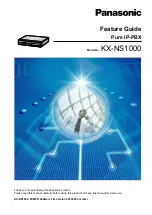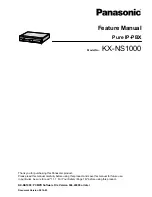
1.26 Networking Features
318
Feature Guide
Location 03:
The hunt sequence by dialling [7+PBX Code 954+XXXX]:
The 1st route — trunk group (TRG) 2
Sending no. to PBX-4:
954#–XXXX
3.2
To Receive a TIE Line Call
a)
Extension Number Method (Access without PBX Code)
Note
When a TIE line call is sent from one PBX to another, the receiving PBX first modifies the
received number according to the assignment for the trunk port: the number of digits
removed, and the number added, are determined by this assignment. Then the PBX
checks whether the completed number is an existing extension number at that PBX.
[Example]
A TIE line call is sent to PBX-2 from PBX-1.
If the number sent from PBX-1 is an
extension number of PBX-2 (e.g., 2011), the
call will be received at extension "2011". If
not, PBX-2 checks the number in the TIE
Line Routing and Modified Table of PBX-2.
If the match is found in the table, the call will
be modified according to the table and send
to the corresponding PBX (PBX-3).
The number sent from PBX-2 "3011" is an
extension number of PBX-3. The call is
received at extension "3011".
PBX-1
PBX-2
Extn. 1011
1 3011
2 3011
PBX-4
Extn. 2011
PBX-3
Extn. 3011
Dials "3011".
3
TIE Line Network
1
2
3
Summary of Contents for KX-TDA15
Page 15: ...Feature Guide 15 Section 1 Call Handling Features ...
Page 91: ...1 5 Making Call Features Feature Guide 91 User Manual References 1 2 1 Basic Calling ...
Page 151: ...1 10 Conversation Features Feature Guide 151 Feature Guide References 1 18 2 Flexible Buttons ...
Page 359: ...Feature Guide 359 Section 2 System Configuration and Administration Features ...
Page 401: ...Feature Guide 401 Section 3 Appendix ...
Page 413: ...Feature Guide 413 Index ...
Page 419: ...Index Feature Guide 419 ...




































